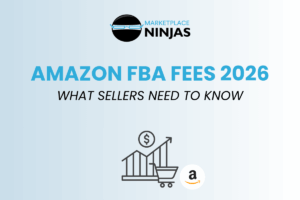In the past five years, there has been a serious shift in how products are being sold on Amazon. Direct to consumer brands, laser focused on Amazon, have steadily taken market share from traditional omni-channel manufacturers. DTC brands now represent over 51% of all sales on Amazon.com and that trend doesn’t appear to be slowing any time soon.
To understand why this is happening, one needs to understand how the rise of the Amazon-centric DTC brands began.
There have been self-proclaimed “gurus” advertising to teach people to sell online for as long as there has been an online. But many people credit Jason Katzenback and Matt Clark (creators of The Amazing Selling Machine) back in 2013, as one of the first programs to teach people to sell on Amazon on a large scale.
The general premise was this:
- Find commodity type products not being sold on Amazon or being sold at prices above traditional brick & mortar retail prices.
- Source and order these products from Chinese manufacturers through websites like Alibaba.com.
- Sell directly to Amazon’s customers utilizing Amazon’s 3rd party selling platform Seller Central and fulfillment network (fulfilled by Amazon or FBA) at or below traditional retail pricing.
Word quickly spread of early success. Individuals that took the course were generating millions of dollars in sales in a very short period of time. Within a few years, there were dozens of similar courses and thousands of small (less than 5 people) DTC brands popping up each year. It was, and still is, very common to find DTC brands selling completely unrelated products like socket wrenches, lemon zesters, and guitar picks side by side successfully in the tens of thousands of units a month. This model typically would be a recipe for failure when launching a new brand, but no so with Amazon. This was due to a few universal truths discovered along the way.
Amazon Truths:
- People engage with Amazon long before they’ve decided what they want to buy. They use Amazon to decide what they want to buy. It’s part store, part search engine, part wikipedia.
- For many types of products, Amazon – and its customers – are brand agnostic.
- Early momentum is key to creating a high-sales volume product.
Amazon Is A Search Engine
During that same five-year period, there’s also been a shift in how consumers make buying decisions. According to multiple consumer surveys, including one done by Survata in December of 2017, almost half of all online shoppers visit Amazon before anywhere else when making a buying decision. While this number is slightly down from the previous year, it still shows that Amazon is the undisputed king of product information resources. DTC brands understand this very well and many design their Amazon sales strategies around ensuring their products appear at the top of the search results when consumers use generic search terms. A great example of this is in the electronics category. If you were to go to Amazon right now and type “Bluetooth Headphones” into the search bar, it’s highly likely that you wouldn’t find a single recognizable brand within the results. DTC brands understand that getting in front of the consumer early in their buying journey is key.
Amazon, and It’s Customers, Are Brand Agnostic For Many Product Categories
Unlike with other mass retailers such as Walmart, Target, and Dollar General, there is little competitive advantage in being an established omni-channel manufacturer when interacting with Amazon. With other channels, buyers play the key role of gatekeeper and decider of which products receive placement on their shelves. Having a good relationship with a buyer could be the difference between success and failure. Amazon has flipped that dynamic on its head. All products are welcome on their channel and premier digital product placement is based for the most part on sales volume. Purchasing decisions are also based on different factors than other mass retailers. While price, availability, and messaging continue to be incredibly important, consumer reviews have now become just as important as the others. One well written positive review can make or break a product. Similarly, one critical product review can seriously negatively effect sales of a product. Savvy DTC brands understand this and put significant emphasis on review generation. Many also utilize Amazon’s Seller Central platform so they are able to control the retail price of their products and strategically price them below established manufacturers. Understanding and taking advantage of the factors that affect Amazon’s consumers buying decisions allow them to gain a significant advantage over traditional industry powerhouses.
Early Momentum Is Key
How and when Amazon displays certain products to their consumers is algorithmically based and the primary driver behind that algorithm is sales volume. Since Amazon’s ultimate goal is to sell products, they show consumers products that previous shoppers have purchased when using that same search term. So, roughly speaking, if a person were to go to Amazon and type in “outdoor firepit”, the products that appear organically in the search results first are those that consumers have purchased the most of in the past. Because most consumers don’t click past the first page of the search results, these first spots are extremely valuable real estate and are not easy to acquire. It’s somewhat of a “chicken or the egg scenario”. Consumers have to be able to find a product to buy that product, but consumers need to buy a product to get on page one to be able to find that product. This is why the launch of a product plays a critical role in its ongoing success. DTC brands understand this and heavily focus on getting Amazon’s customers to buy their products using specific targeted search terms. Many of them attempt to manipulate Amazon’s algorithm using sophisticated URLs to trick the system into thinking buyers made a purchase using that search term. Others spend tens of thousands of dollars per product to work with groups of thousands of buyers providing heavy discounts, up to 90% off, to ensure their products are bought using specific search terms so they appear on page one.
What Can Established Brands Do?
Below are a few relatively easy steps that established brands can take to counteract this trend :

1. Fully Invest in the Channel
It was Sun Tzu that said “To know your Enemy, you must become your Enemy” and these words of advice ring true. There are many ways to better understand the channel: hire someone with deep Amazon experience, pay a consulting group, or educate a current employee. The key is to pick one and move forward. Understanding how Amazon operates will only become more and more important.

2. Improve Your Presence
In the very least, put yourself in your target customers shoes and do a search for your brand on Amazon. Ask yourself “Is this the face I want to present to potentially millions of customers seeing my brand for the first time?” If not, make it look how you want it to look.

3. Leverage Amazon’s Advertising Platform
If you are currently advertising on traditional search engines like Google or Social Media platforms like Facebook and not on Amazon you’re missing out. As was mentioned above, Amazon now represents over 49% of all initial consumer product searches. Amazon is the new Google and it’s critical to treat it as such.
While DTC brands are currently in the lead, established brands can overcome the deficit and eventually win the Amazon arms race.





